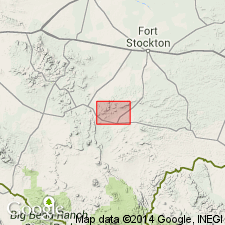
- Usage in publication:
-
- Dugout Mountain Member*
- Modifications:
-
- Original reference
- Dominant lithology:
-
- Limestone
- AAPG geologic province:
-
- Permian basin
Summary:
Pg. E4-E5, pls. 1, 2. Dugout Mountain Member of Skinner Ranch Formation. West of Lenox Hills on Dugout Mountain a considerable thickness of rock occurs above Sullivan Peak Member of the Skinner Ranch and below lowest beds of Cathedral Mountain Formation. This interval includes limestone members of old Leonard Formation numbered 2-4 by King (Univ. Texas Bull. 3038, 1931). Investigation of the numbered beds in the Lenox Hills and those in Dugout Mountain has shown that the numbers do not all correspond. Rock and fauna of the first limestone in each of the two localities indicate a correlation --it is Sullivan Peak Member. The higher number limestones on Dugout Mountain do not resemble those bearing corresponding numbers in the Lenox Hills. Instead, the fifth limestone on Dugout Mountain corresponds to second limestone in Lenox Hills, and third and fourth limestones are tongues in overlying Cathedral Mountain Formation. The interval in Dugout Mountain between top of Sullivan Peak Member and base of fifth limestone is herein named Dugout Mountain Member. As such it includes the second, third, and fourth limestones of King (1931) and the shaly intervals between them. These three limestone beds appear to thin and perhaps to converge northeastward along the back slope of Dugout Mountain. They pinch out somewhere in covered valley between Dugout Mountain the Lenox Hills, and the shaly Dugout Mountain Member above the Sullivan Peak is only tentatively identified in the Lenox Hills. At type locality sequence is mostly yellow shale, has three limestone tongues, and is 514 feet thick. Thins to northeast. Age is Early Permian (Leonardian).
Type locality: on the north slope of Dugout Mountain along line of King's (Univ. Texas Bull., no. 3038, p. 133, 1931) section 7, Glass Mountains, Brewster Co., western TX.
Source: US geologic names lexicon (USGS Bull. 1350, p. 223-224).
For more information, please contact Nancy Stamm, Geologic Names Committee Secretary.
Asterisk (*) indicates published by U.S. Geological Survey authors.
"No current usage" (†) implies that a name has been abandoned or has fallen into disuse. Former usage and, if known, replacement name given in parentheses ( ).
Slash (/) indicates name conflicts with nomenclatural guidelines (CSN, 1933; ACSN, 1961, 1970; NACSN, 1983, 2005, 2021). May be explained within brackets ([ ]).

